Introduction
Fish are fascinating aquatic animals! There may be up to 35,500 different species of fish – that’s more than all of the species of birds, mammals, amphibians and reptiles combined.1https://www.worldatlas.com/animals/how-many-species-of-fish-are-there.html Fish can look and behave so differently that you might not even think they are the same phylum (family of animals). Because fish first evolved over 500 million years ago, they’ve had plenty of time to adapt to their unique surroundings. This is why some fish, like mudskippers and bichirs can survive out of water, and why other fish, like the Antarctic toothfish can survive in freezing temperatures.
Because fish live underwater and out of sight, they can seem very strange to us. It’s easy to forget that they are thinking, feeling creatures with rich, interesting and valuable lives. Seventy per cent of the Earth’s surface is water and almost all of it is home to fish, so we should treat them with the respect they deserve as one of the planet’s earliest and most successful inhabitants.
Fascinating facts
Trading places

Clownfish can change sex. When the dominant female dies, the most dominant male changes sex and takes her place.2https://www.ncbi.nlm.nih.gov/pmc/articles/PMC5066260/
Hunting parties
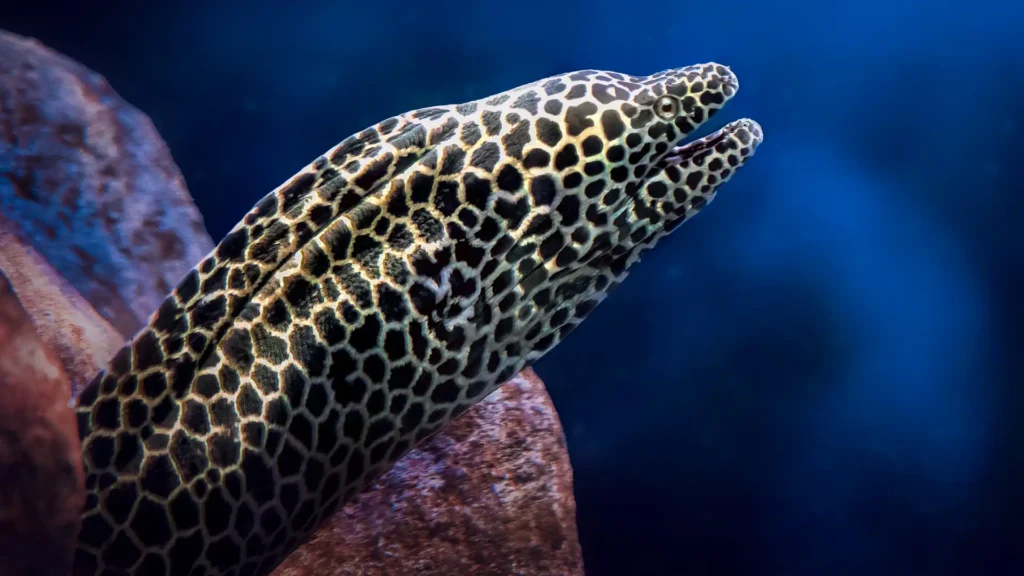
Several types of fish work together when they hunt. An interesting example is the grouper and moray eels who hunt together in a cooperative manner and both species benefit from the partnership. Groupers hunt in open water in daytime, while moray eels are nocturnal hunters that sneak through reef crevices. Their complementary hunting strategies give them an advantage when hunting together and they use signals and gestures to talk to each other and help each other catch prey.3Balcombe, J., 2016. What a Fish Knows: The Inner Lives of our Underwater Cousins. US: Scientific American.
Cleaning services

Bluestreak cleaner wrasse are most well-known for their strange feeding habits. They eat parasites and the diseased tissue of larger fish by entering their mouths and gill openings. Large fish queue up at well-known cleaning stations and wait their turn to be attended to by a cleaner wrasse.4https://india.mongabay.com/2019/07/where-do-fish-go-for-a-spa/
A whale of a fish

The largest fish in the world is a shark – specifically, the whale shark – which grows to more than 65 feet (20 metres) long (approximately the length of two buses) and may weigh several tonnes. They largely eat plankton by what is known as ‘filter feeding’ but have over 4,000 3mm length teeth!5https://www.fisheries.noaa.gov/national/outreach-and-education/fun-facts-about-fascinating-fish
Fish form relationships

Some species of fish, such as the cichlid, form lifelong partnerships. Together they look after each other and their babies for months – showing sophisticated and strong care. Fish are also very selective about who they let into their friendship group, only making friends with fish they trust.6https://www.ualberta.ca/en/newtrail/ideas/the-love-lives-of-fish-and-humans.html There are also many other stories of fish recognising and forming friendships with divers. One example is the beautiful friendship between Japanese diver Hiroyuki Arakawa and Yoriko, the Asian sheepshead wrasse,7https://www.boredpanda.com/diver-fish-25-year-friendship-hiroyuki-arakawa-japan/ captured in a viral video, showing Arakawa’s custom of greeting the fish with a kiss on his big head.
Frozen fish
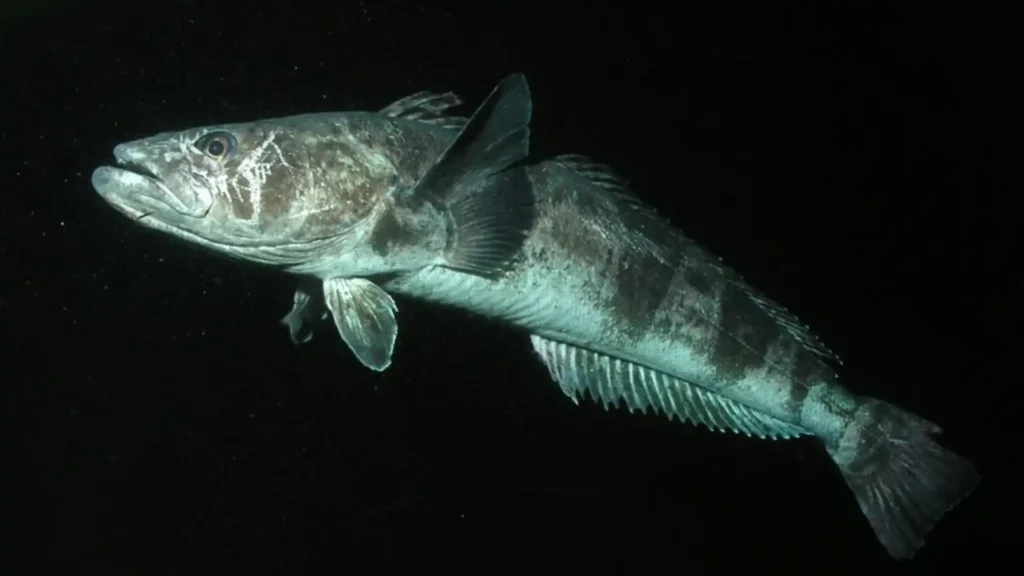
Antarctic toothfish are large, deep-sea predatory fish, found only in the ice-laden Southern Ocean. To survive in sub-freezing temperatures, they have evolved a slow heartbeat – one beat every six seconds – and have developed special proteins in their bodies that act like anti-freeze to prevent their blood from freezing.8http://icestories.exploratorium.edu/dispatches/antarctic-projects/antifreeze-fish/index.html
Best of both worlds
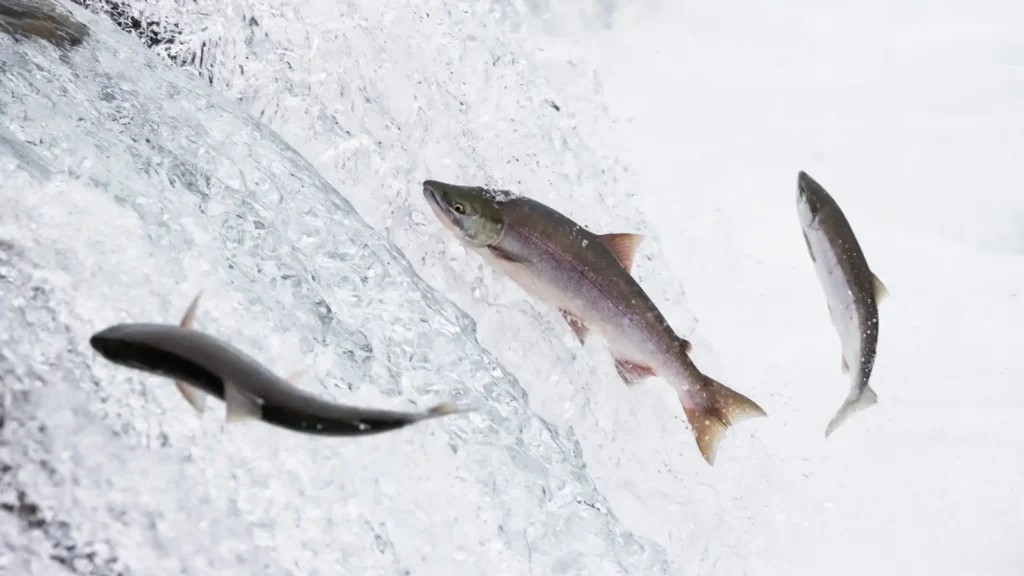
Some fish species can live in both freshwater and saltwater. Salmon are born in freshwater but spend most of their lives in the sea, only returning to the freshwater streams where they were born to spawn.9https://www.livescience.com/32167-can-saltwater-fish-live-in-fresh-water.html
A fish out of water
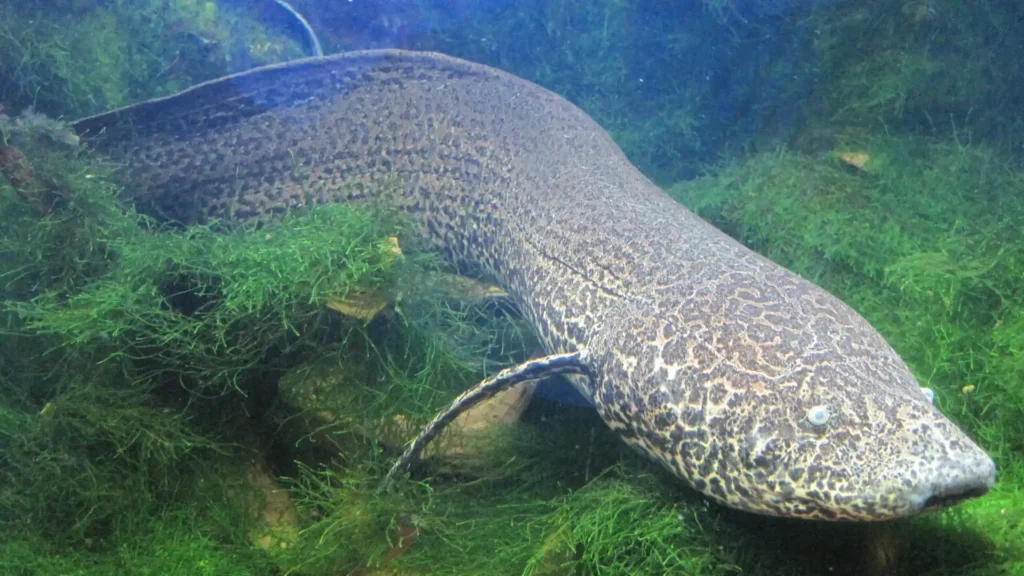
Lungfish can live out of water for several years. They have both gills and a lung, secrete a mucus cocoon and burrow themselves under unbaked earth. Lungfish take in air to their lung through a built-in breathing tube that leads to the surface.10Head, H., 2008. Amazing Fish (Amazing Life Cycles). New York: Gareth Stevens Publishing
Precious poo
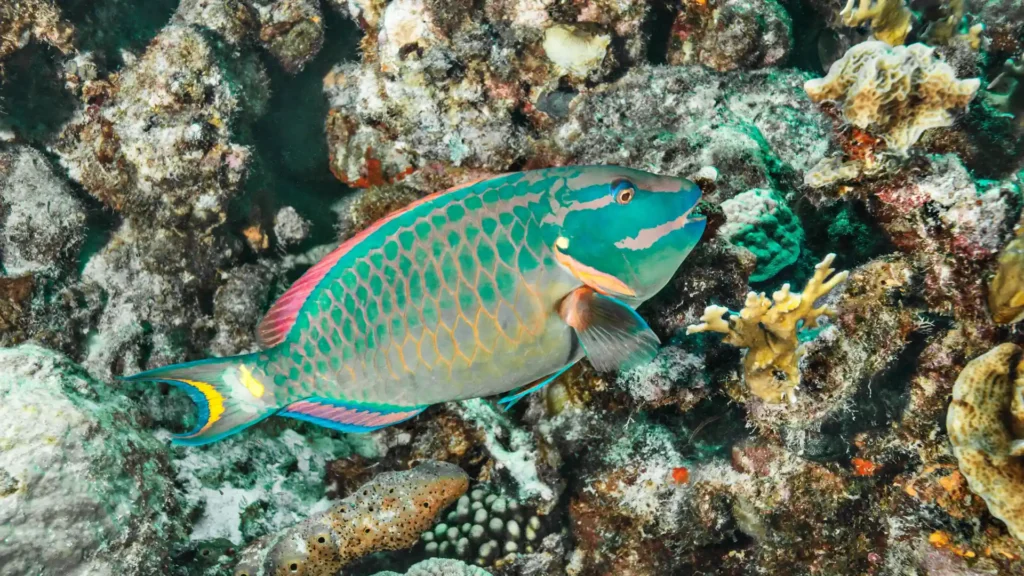
Coral-crunching parrotfish excrete an average 14 stone (90 kg) of sand each year by pulverising chunks of reef with their grinding teeth to access the algae-filled polyps inside. Without the work of the fish, many beaches, atolls and small islands would disappear leaving the people who live on them without a home.11Field, M., 2014. The Catch: How Fishing Companies Reinvented Slavery and Plunder. New Zealand: AWA Press.
Big baby sharks

Frilled sharks carry their babies for over three years, the longest known pregnancy in nature. Most sharks lay eggs but frilled sharks give birth to live young. They feed on a yolk sac in their mother’s belly and she only gives birth when they are big enough to fend for themselves. Litter sizes range between two and 10 offspring.12https://www.jstage.jst.go.jp/article/jji1950/37/3/37_3_273/_article/-char/en
Fish have great memories
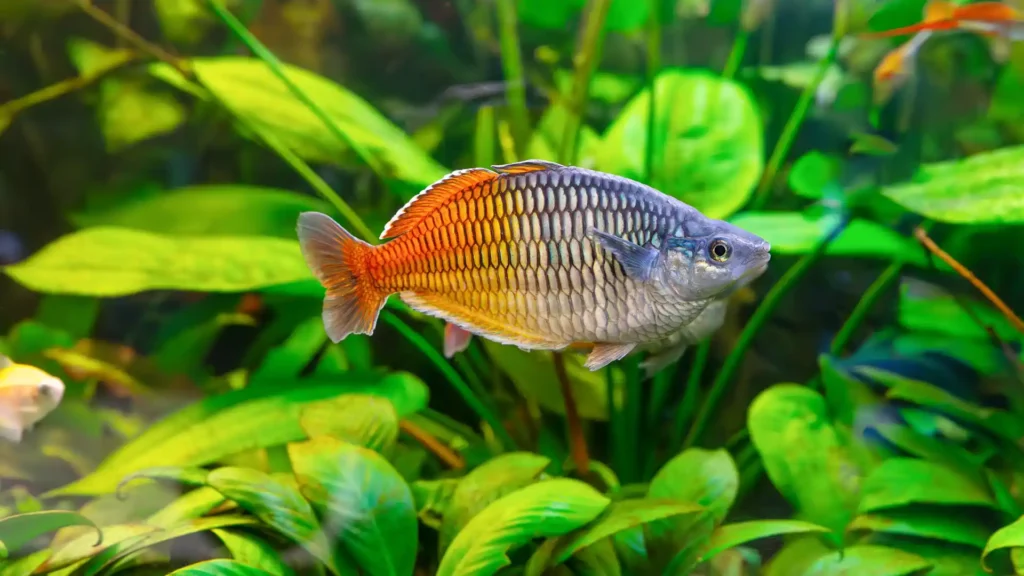
Scientists have proved that it is an ignorant myth that fish have poor memories. Fish have powerful memories – essential for their survival! An example of sophisticated memory comes from Professor Culum Brown of Macquarie University, Australia. While teaching students about how to design scoops for fishing trawlers, in order to allow unwanted rainbowfish species to escape, Culum noticed that his sample fish became quicker at finding the escape hole on subsequent attempts. He tested this theory more thoroughly later on, finding that the rainbowfish that were experienced with the scoop not only remembered where the escape hole was, but also learnt to U-turn before the scoop to easily escape the trawl.
Eleven months after the experiments ceased, the same fish were able to repeat the behaviour when reintroduced to the scoop, demonstrating long-term memory in fish. But there’s more – when new fish were grouped in with experienced fish, they too would find the hole faster. This demonstrates a social ability to learn or copy between individuals.13https://www.bbc.co.uk/programmes/articles/2hQLzX4xB9nryvlYRV339xy/are-fish-memories-really-as-bad-as-we-think-they-are
Fish farming in Uganda
The number of fish farmed in Uganda varies wildly depending on source. According to Uganda’s National Agricultural Advisory Services (NAAS), Uganda produces 15,000 tons of fish from fish farms every year.14https://naads.or.ug/fisheries/ However, this may be out-of-date as the United Nations’ Fishery and Aquaculture Statistics Yearbook 2021, says Uganda produces 138,558 tons of farmed fish and 621,987 tons of wild-caught fish.15https://openknowledge.fao.org/server/api/core/bitstreams/2be6c2fa-07b1-429d-91c5-80d3d1af46a6/content That’s approximately 34 million fish killed on farms and 150 million taken from the wild. The fish most commonly fished and farmed are Nile perch, tilapia and catfish.
How fish are farmed
Fish are wild-caught from lakes and rivers, or farmed in either outdoor ponds or more modern indoor fisheries.
Wild-caught fish
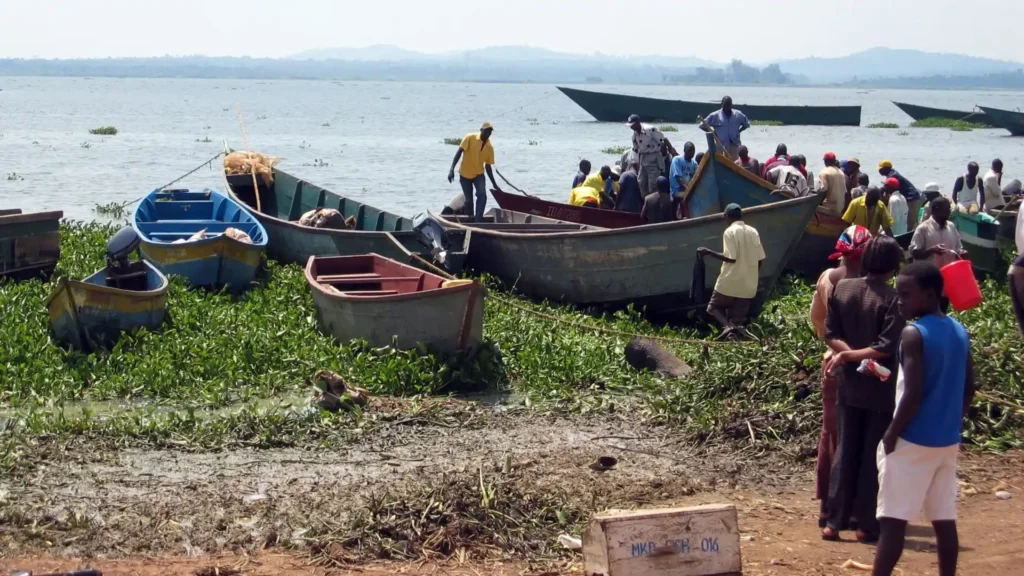
The vast majority of fish killed and eaten in Uganda are wild-caught from lakes and rivers.14https://openknowledge.fao.org/server/api/core/bitstreams/2be6c2fa-07b1-429d-91c5-80d3d1af46a6/content Up to 17 per cent of Uganda’s surface is covered in water and there are five major lakes – Victoria, Kyoga, Albert, Edward and George – that were once an important source of food for local villagers.16https://aquadocs.org/bitstream/handle/1834/35259/fisheries.pdf?sequence=1&isAllowed=y But, since the 1950s, fishing has been carried out on a larger, industrial scale.17https://catholic-animals.com/uncategorized/fishing-in-uganda-by-fr-ssekabira-deusdedit/ Lakes Victoria, Albert and Edward contribute 95 per cent of Uganda’s annual catch, and Lake Victoria contributes 50 per cent alone.18https://unctad.org/system/files/official-document/aldc2017d2_ch09_en.pdf
Large-scale fishing has caused many problems for Uganda’s lakes, and the fish that live in them. Overfishing has caused many fish species to decline and disappear. Fish were once caught by fishermen in small canoes with spears and hooks, but now large nets are put out at dusk and hauled in at dawn. Up to 60 per cent of species have either completely disappeared or have become virtually extinct in certain lakes.15https://aquadocs.org/bitstream/handle/1834/35259/fisheries.pdf?sequence=1&isAllowed=y
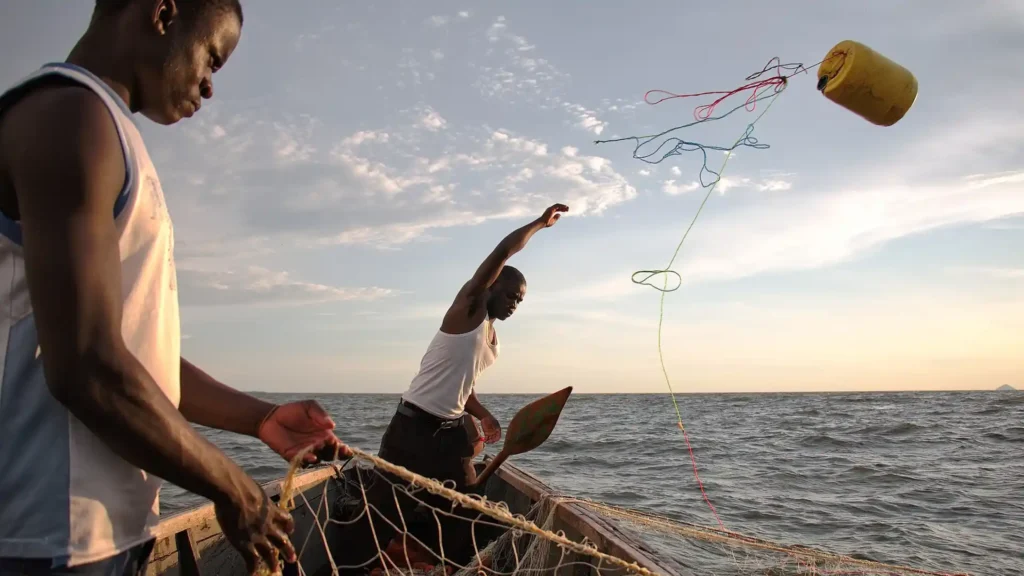
Fisheries also introduced the Nile perch to some of the lakes with devastating results. The aggressive perches out-competed the native species for food and attacked and killed the smaller fish in the lakes. The native fish of Uganda’s lake were used to living in a peaceful, balanced environment until the fisheries got involved. Nile perch now make up 80 per cent of the fish in some places and totally dominate the ecosystem.19https://www.fao.org/4/t0037e/T0037E09.htm#:~:text=Some%20authorities%20consider%20that%20disastrous,cichlid%20herbivores%20and%20detritus%20feeders.
When thousands of Nile perch washed up on the shores of Lake Victoria and Kyoga, severe weather patterns, caused by climate change, were to blame: “recent storms on the lakes caused mixing of the different waters thereby reducing the amount of oxygen in the lake. Nile perch suffocates when exposed to low levels of oxygen.”20https://www.bukedde.co.ug/world/NV_87884/what-is-killing-fish-in-ugandas-lakes
After the death of so many Nile perch, fishermen turned to tilapia instead, but they have already been overfished and so there are not many left.
Water hyacinth, an invasive water plant, is common in Uganda’s lakes and makes fishing difficult. In an attempt to control the invasive species, fishermen use chemicals to kill the plant. This has resulted in poisonings and human deaths when people have eaten contaminated fish.21https://core.ac.uk/download/pdf/11023763.pdf Where the water hyacinths have made it too difficult to catch fish, fishermen have resorted to using farming chemicals to kill the fish. Even when chemicals are not deliberately put into the lakes, chemical run-off from farms, and soaps and cosmetics manufacturers on Kenya’s lakeshore, is a big problem for Uganda, polluting Lake Victoria.
Outdoor ponds
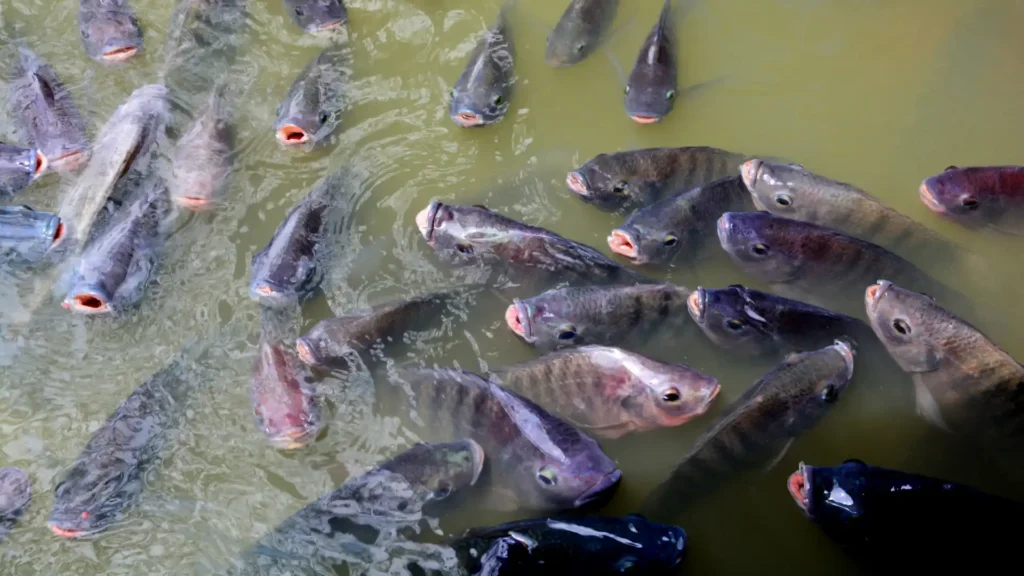
There are over 20,000 ponds across Uganda, each with a surface area of 500 square metres.13https://naads.or.ug/fisheries/ Thousands of fish – usually catfish and tilapia – are overcrowded in these ponds and even underwater cages. Just like in factory farms on land, fish face serious problems because of this cruel treatment.
Fish have sensitive skin so don’t like touching each other. However, because so many are crammed into a pond, they always bump into each other, which causes fights and injuries. When fish are packed so tightly, diseases and parasites, such as lice, can easily spread from fish to fish.
The pond water is often very dirty and stagnant so the fish struggle to breathe, and many die when they are young because there is not enough oxygen in the water.22https://www.harvestmoney.co.ug/key-facts-about-breeding-tilapia-2/
Indoor fisheries
In some parts of Uganda, such as Kadepo, more modern fish farms are springing up.23https://www.youtube.com/watch?v=GetDbSrRPjo&t=110s In these farms, up to four tons of fish can be ‘harvested’ in six months.
Tilapia are mouth-brooders, like many other fish in the cichlid family. A female tilapia is able to reproduce at eight months old and can produce 100 babies in one week. After the male has fertilised the female’s eggs, she gathers the eggs in her mouth to protect them. In nature, even after the eggs hatch, the baby fish (fry) will dart back into her mouth for safety. However, most farms strip the eggs from the female before they hatch to incubate them. On other farms, the fry are harvested after 21 days.22https://www.youtube.com/watch?v=GetDbSrRPjo&t=110s
To harvest the eggs, first the tilapia need to be caught and males separated from females. In indoor fisheries, a large net is dragged across the bottom of the pond, beneath the swimming fish. The water level is then dropped and the fish raised out of the water trapped in the net. The males are returned to the pond while the females are left struggling in the net, gasping for air with a mouth full of eggs. The farmer then opens the female’s mouth and gills with his fingers and dunks her into a bucket of water, flushing her precious eggs from her mouth. If the eggs have already hatched in her mouth, the fry are put in a separate container. Once the female has had her eggs or fry stripped from her, she is tossed back in the pond.24https://www.youtube.com/watch?v=rfL3fhorneM&t=1s
Female tilapia are most productive at the size of 150 to 300 grams. If they grow bigger than this they are harder to handle and are less productive. After the eggs have been harvested, they are placed in incubation tanks to hatch.
How fish are killed
When fish are killed for food, they are suffocated, bashed on the head with a blunt object or cut open with a knife. Little or no consideration is given to their welfare, even though we know fish experience fear and feel pain.25Braithwaite, V., 2010. Do Fish Feel Pain? Oxford: Oxford University Press.
Fish have neurons called nociceptors. Neurons send information from the world around us to our brain. Nociceptors allow fish to feel pain and harm, such as high water temperatures, pressure and chemicals in the water. Just like mammals, fish produce natural painkillers to help deal with pain.24Braithwaite, V., 2010. Do Fish Feel Pain? Oxford: Oxford University Press. Fish scientists have conducted many – often cruel – experiments that prove fish feel pain beyond any doubt.26https://hakaimagazine.com/features/fish-feel-pain-now-what
Not only do fish feel pain, but they are self-aware. This means they have a sense of being an individual, just like you and me. A gold standard among scientists investigating whether animals have a sense of self is the “mirror self-recognition test.” If an animal is able to recognise her or himself in a mirror, it is evidence of visual self-awareness, ie the fish knows who she or he is. In the Osaka City University study, a small number of fish had a mark placed under their throats while under anaesthesia. When given a mirror, the fish could see the mark and tried to rub it off by scraping themselves on rocks.27https://www.theguardian.com/environment/2024/sep/14/do-fish-have-feelings-sydney-university-research-project This puts the self-awareness of fish up there with primates, elephants and dolphins!
Fish are more clever and complex than we think (exposing human ignorance!). They can learn, have long memories, experience pain and form relationships. Imagine then, what it is like for a fish to be pulled from their home, suffocated or brutally sliced open from head to tail while they are still alive. The only way to avoid causing such cruelty is to stop eating fish and go vegan!
References
References
- 1
- 2
- 3Balcombe, J., 2016. What a Fish Knows: The Inner Lives of our Underwater Cousins. US: Scientific American.
- 4
- 5
- 6
- 7
- 8
- 9
- 10Head, H., 2008. Amazing Fish (Amazing Life Cycles). New York: Gareth Stevens Publishing
- 11Field, M., 2014. The Catch: How Fishing Companies Reinvented Slavery and Plunder. New Zealand: AWA Press.
- 12
- 13
- 14
- 15
- 16
- 17
- 18
- 19
- 20
- 21
- 22
- 23
- 24Braithwaite, V., 2010. Do Fish Feel Pain? Oxford: Oxford University Press.
- 25Braithwaite, V., 2010. Do Fish Feel Pain? Oxford: Oxford University Press.
- 26
- 27

